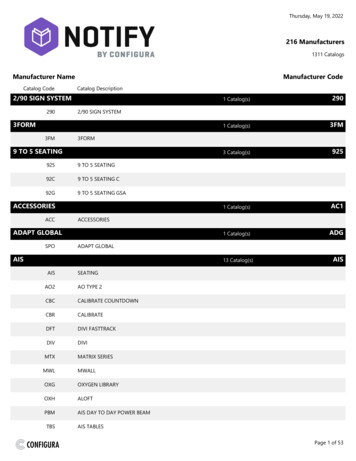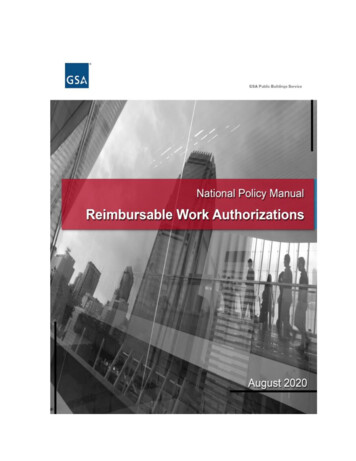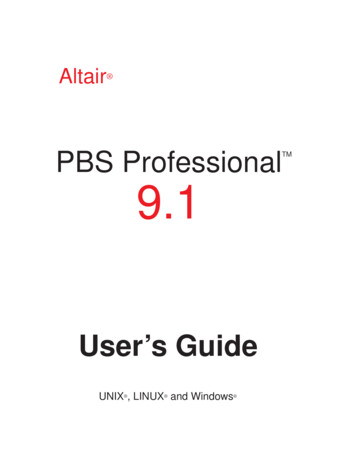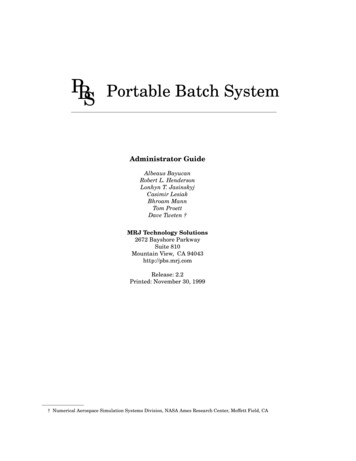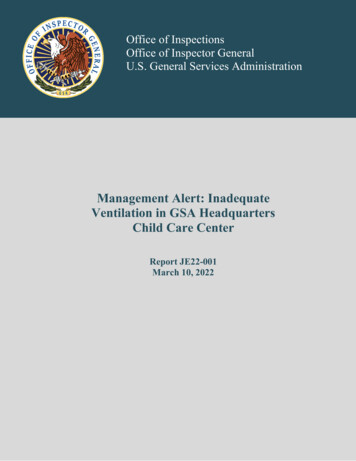
Transcription
GSA PBS Customer ForumHosted by theOffice of Portfolio Management and Customer EngagementJune 25, 2018Pricing Policy Basic Training
Pricing Policy Basic TrainingPresented byKelly EllisonSenior Pricing SpecialistPricing Policy and Tool DivisionOffice of Portfolio Management and Customer Engagement2
Training Topics Occupancy Agreements (OA)Building ShellTenant Improvements (TI)Operating CostsTenant Agency Rights3
Space Pricing Federally owned space – Rent is based onan appraisal or return on investment, withother applicable charges added Leased space – Rent is a passthrough ofthe underlying lease contract rent plus:– any standard operating costs not performedthrough the lease– PBS lease feePDG Section 1.24
The OccupancyAgreement5
The Occupancy Agreement (OA) A complete statement of the business termsgoverning the relationship between PBS and thetenant agency for a specific space assignment Serves as the billing document Covers financial specifics and responsibilities of bothparties Not a contract, but a formal agreement between thesigning partiesPDG Sections 2.1 and 3.16
Why is the OA Important? Keep customer informed of rent charges or projectcosts Help ensure PBS does not incur financial obligationsin excess of the terms the customer agency is willingto commit Help to eliminate Rent disputes and appeals Prospectus submissions must have signed OAs7
Four Parts of the OAPDG Sections 2.1 and 3.18
Description of Space and Services Square Footage of Space Number of Parking Spaces Type of Space Building Name and Address Occupancy TermPDG Sections 2.1.1 and 3.1.19
OA Term The OA gives the tenant agency a right to occupy thespace for a specific duration called the OA term Leased Space– OAs should not exceed and are usually coterminouswith the lease term– Option period not included Federally Owned Space– Standard OA term is 10 yearsPDG Sections 2.1.1 and 3.1.110
OA ClausesClause TypeRequirementApplicationPBS standard clausesMandatoryRequired for all occupancies,separate set for leased andfederally owned spaceAgency-specific clausesMandatory oroptionalCould apply to all of a tenantagency’s occupancies(mandatory) or just a subset(optional)Optional clausesOptionalCould apply to any occupancy,based on the situationAd hoc clausesOptionalSpecific to one occupancyPDG Sections 2.1.2 and 3.1.211
PBS standard clauses Financial Obligations––––Four-month space release rightTI allowanceBuilding servicesPricing of space Schedule and Project Delays– Tenant caused delay– PBS caused delay Cancellation Rights12
PBS standard clauses No alterations without prior approval by PBS RWA for TI above the allowance Move policy Replacement and renewal responsibilities– Shell– TI13
PBS standard clauses Rent Commencement– Tenant agency's obligation to pay rent when spacegoverned by the OA is: substantially complete operationally functional– Occupancy and rent start will be coordinated with thetenant– Phased occupancy allowed– No grace period for moves or installation of personalproperty items unless included in the contract14
Substantial Completion Tenant given opportunity to participate in a walk-through of thespace prior to final acceptance by PBS Leased Space– granting of an occupancy permit and/or PBS's acceptance ofthe space as substantially complete in accordance with thelease– Government has access to the premises and occupancy,possession, use and enjoyment thereof, as provided in thelease Federally Owned Space– PBS' s acceptance of the space as substantially complete inaccordance with the general construction contract– Government has access to the premises and occupancy,possession, use and enjoyment thereof, as provided in thegeneral construction contract15
Operationally functional Building systems function Building-specific safety and securityfeatures operational Related space necessary for a tenant tofunction must be complete16
Financial Summary Preview of the tenant agency’s Rent bill Itemizes the cost components of the Rentpayment Summarizes the financial terms and lumpsum payment requirements Serve as a planning and budgeting toolPDG Sections 2.1.4 and 3.1.417
Signature Page OA signature required before incurring significantcosts to pursue the project or procurement– e.g., awarding a lease contract, purchasing a site orawarding a design contract If the tenant agency later backs out of the signed OAagreement, PBS reserves the right to seekreimbursement Certain circumstances where PBS can proceedwithout tenant agency signature– e.g., forced movePDG Sections 2.1.3 and 3.1.318
Revising an OA Events requiring a signature– Tenant agency expands or reducesspace– Services are added or removed– PBS agrees to fund additional TIs– PBS or the tenant agency wishes torevise the OA terms (must mutuallyagree)PDG Section 2.1.5 and 3.1.519
Revising an OA Events requiring notification (no signature)– Joint use amenities added or removed– Security fixtures or features approved by the FacilitySecurity Committee (FSC)– Parking spaces added or removed– Antennas added or removed– Lease extensions advancing the expiration date onlyPDG Sections 2.1.5 and 3.1.520
Revising an OA Federally owned space events requiring a notification(no signature)– Continuing occupancy no change in USF and no new TIs– 10-year fully serviced shell rate reset to market no change to the USF– Building remeasurement– Space errors identified through SDM processPDG Sections 2.1.5 and 3.1.521
Revising an OA Annual rate updates made to OA (nosignature or notification)– Operating costs– Real estate taxes (leased space only)– Parking– Antennas– BSAC security– Joint usePDG Sections 2.1.5 and 3.1.522
Building Shell23
Building Shell The complete enveloping structure, the base building systems,and the finished common areas of a building that adjoin thetenant areas. Shell in base building includes:– Base structure and building enclosure (e.g., windows)– Base building electrical & mechanical systems– Common areas (e.g., lobbies, elevators, restrooms, garages) Shell in tenant areas includes:– Wall board on exterior perimeter & interior core walls– Common corridor stud walls without gypsum board– Suspended acoustical tile ceiling with parabolic fluorescentlighting (open office layout)– Concrete floorPDG Sections 2.4.1 and 3.5.124
Building ShellSuspended ceiling withfluorescent light fixturesHVAC distribution for generaloffice spaceLevel Concrete FloorElectrical service to floorfor general office spacePDG Section 2.4.1 and 3.5.1Primed gypsum wall boardon exterior perimeter walls& core elements25
Building Shell PDG building shell definition supports regional consistency inthe application of TI allowances PBS must use the shell definition in its entirety and withoutdeviation Building standards and design guides are not part of the buildingshell merely because they are called “standards” Tenant agency-driven upgrades to building shell are to beseparately priced and considered TIs Buildings specific security items are not included in shellPDG Section 2.4.1 and 3.5.126
Shell Rent – Leased Space Passthrough of the underlying PBS lease contractshell rent– Lease may have step rents Lessors use shell definition in the RLP/Lease todevelop their shell rent rate– Design intent drawings (DIDs) typically included in theshell requirements for leases, but is optional– PBS policy is that cyclic painting and carpetreplacement can be included in leases as a shell costPDG Section 2.4.127
Shell Rent – Federally Owned Space Shell rent based on a FAR appraisal Shell rents are established for 10 yearperiods At a minimum, a new FAR appraisal every10 years 50% for general storage space, all otherrentable area has the same shell ratePDG Section 3.5.328
Example of GNS Space29
Tenant Improvements30
Firewall between Shell & TI The shell and TI distinction is animpermeable barrier or "firewall" acrosswhich funding cannot shift Exception for prospectus level projects– Shell funds can be moved to TI Only with tenant agency’s consent Only after other remedies have been examinede.g., plans and specifications review, descoping,value engineeringPDG Section 3.5.231
Tenant Improvements The finishes and fixtures that typically take spacefrom the shell condition to a finished, usable condition Tenant agency elects how its space is to be finished,as long as the space is finished, functional, andcompliant with all applicable building codes andstandards The existence of building standards does not meanthey are part of shell – they are still TIs (e.g., suiteentry door specification, restricted color palettes)PDG Sections 2.5.1 and 3.6.132
Shell vs TI ExampleSuite Entry DoorWood Wall &Stainless SteelLogoBuilding SignageWood(Common Area)Terrazzo Tile(Tenant Space)LegendGlass Wall with Leaf Graphic(Common Area)ShellTenant ImprovementTerrazzo Tile(Common Area)33
Tenant Improvement Allowance Funding source that enables the space to be built out TI allowance has two components - general and customization Provides flexibility, choice, and savings incentives Commonplace in the commercial real estate market Allows both PBS and lessors to budget more reliably Helps PBS and tenant agencies comply with appropriations lawand with OMB requirement that PBS set limits on amounts thatcan be amortized in RentPDG Sections 2.5.3 and 3.6.334
Application of TI Allowances Tenant agency elects how its space is to be finished Rent payment is lower if an amount less than theallowance limit is used If the full allowance is not used for initial buildout, it isno longer available Can only be used to pay for items that are realproperty, or which become real property whenattached or affixed to the buildingPDG Sections 2.5.9 and 3.6.935
Example of Real Property TIThe shelving system to the right is realproperty. The shelving doesn’t have fixedaisles but is mounted on top of a mobilecarriage and the system is on rails that aregrouted/anchored to the floor.The system to the left ispersonal property. It is ahigh density mobile shelvingwhich sits on top of the floor.36
TI Cannot Fund Personal PropertyExamples Include: Furniture Microwaves Refrigerators Artwork Personal computers Audiovisual equipment Televisions for conference rooms Phone handsets Physical relocation expenses of personal propertyPDG Sections 2.5.9 and 3.6.937
Application of TI Allowance Initial occupancies (including expansions)– New space, new tenant– Tenant agency provided the full TI allowance– Tenant agency cannot buy down the general allowancein first generation space through use of an RWA Backfill occupancies– 2nd generation space, new tenant– The full TI allowance may be provided to tenantagency, subject to availability of fundsPDG Sections 2.5.3 and 3.6.338
Application of TI Allowance Midoccupancy / post initial occupancy––––Same OA term, same spaceTIs typically funded by the tenant agencyNo obligation to provide TI allowanceSubject to availability of funds, full or partial TI allowance may beprovided to tenant agency, but this is not typical Continuing occupancies– New OA term, same space, same tenant– TI allowance requested typically just minor alterations or carpet andpaint– Leased Space Tenant agency provided the full TI allowance– Federally Owned Space Tenant agency provided the full or partial TI allowance, subject toavailability of fundsPDG Sections 2.5.3 and 3.6.339
General TI Allowance Takes the space from shell to “vanilla” office space Set nationally and indexed to local construction costs– Currently 38.95 per USF (Washington, D.C.) Covers cost of “typical” office tric & telephone outletsPDG Sections 2.5.4 and 3.6.440
Customization TI Allowance Takes the space from “vanilla” office space to spacespecifically designed to function for a particulartenant agency Not intended to eliminate the need for lump sumRWA payments Customization allowances are not adjusted becausethey are a percentage of the general allowance,which is already adjusted for inflation and indexed tolocal construction costsPDG Sections 2.5.5 and 3.6.541
TI Allowance by Tier PBS created a series ofcustomization tiers– tier 0 to tier 6 Each tier is equal to 10% of thevalue of the general allowance Each tenant agency and bureauis assigned a tierPDG Sections 2.5.6 and 3.6.6 38.95 per USFx Local Construction Index General AllowanceGeneral Allowancex 10% for each Tier Custom AllowanceGeneral Allowance Custom Allowance Total Allowance42
TI Allowance Amortization - Leases Amortization term usually the firm term of the lease Two rules for limiting amortization terms for TIs:– The amortization term must not exceed the economic life of theimprovements– The amortization term must not exceed the term of the OA Exception: Lessors, with PBS and tenant agency agreement, can setamortization term beyond the lease firm term provided no lump-sumcosts due if PBS exercises termination rights or leaves at the end of thelease term Multiple amortization periods can be done for special cases such asphased projects Interest rate negotiated between the successful offeror and PBSPDG Section 2.5.843
TI Allowance Amortization - Owned Standard amortization term is 10 years– Amortization period for courtrooms and chambers assignments can be20 years Two rules for limiting amortization terms for TIs:– The amortization term must not exceed the economic life of theimprovements– The amortization term must not exceed the term of the OA Multiple amortization periods can be done for special cases such asphased projects Interest rate set annually, 10 year Treasury plus 12.5 basis points– 2.985% as of March 2018.PDG Section 3.6.844
Lump-Sum Payment Options for TITiming of LumpSum PaymentRequirementPayment MethodAbove the TI allowance – RWAAt assignmentinceptionPBS allows the tenant agencyto use lump-sum payments to For relet space, any part of thelower the TI and/or to cover TI allowance – RWA (see sectioncosts above the TI allowance 2.5.10.B for additional detail onrelet space)PBS requires a lump-sumAt the time a tenantamount equal to theagency exercises itsoutstanding balance on the TIs Rent through OA Toolright to release spacethat PBS has been amortizingback to PBSin the RentPDG Sections 2.5.10 and 3.6.1045
Lump-Sum Payment Options for TITiming of Lump-SumPaymentAt any time during theOA term in which thetenant agency wantsreimbursable spacechangesRequirementPBS requires tenant agencies tofund, in full and in advance, thecost of space changes to anexisting assignmentPayment MethodRWAPBS requires the forcing tenantWhen an expandingagency to pay PBS for thetenant agency displacesRent through OA Toolunamortized balance of the TIs ofanother tenant agencythe displaced tenant agencyPDG Sections 2.5.10 and 3.6.1046
Operating Costs47
Operating Costs Leased Space– Direct pass-through of lease contract cost forstandard services to customer agency– Typically escalated annually by CPI Federally Owned Space– Based on market appraisal, not PBS costs– Reset to market every 10 years– Escalated annually by OMB Inflation FactorPDG Sections 2.6 and 3.748
Op Costs – Utilities in Lease Leased Space– Consistent heating or cooling for one shift witha minimum of 10 operating hours Lease may provide HVAC hours in excess of 10hours depending on local market practice– Lease should reflect the building’s normaloperating hours– Reimbursement required for HVAC outsidenormal hours specified in lease Except server rooms 500PDG Section 2.649
Op Costs – Utilities in Owned Space Federally Owned Space– Provide 10 hours consistent heating or cooling– Property Manager in consultation with tenantsdetermine standard building hours– Reimbursement required for HVAC outsidenormal 10 hour specified periodPDG Section 3.7.150
Standard Custodial ServicesFederally Owned SpaceLeased Space* Essentially the sameEssentially the same Essentially the sameEssentially the same Essentially the same Washing windows twice a year Plus shampoo every two yearsEssentially the same Essentially the same Vacuuming, sweeping, and dustingDamp mop and spray buff resilientfloorsEmptying and hauling trashServicing restrooms, lobbies,corridors, and other common areasServicing loading docks andplatformsWashing windows (at least onewashing per year or more asdetermined by region)Carpet spot cleaningSnow and ice removal, and lawnand grounds maintenanceIntegrated pest management*SFO Section 4.10 - Janitorial Services (Aug 2008)51
Tenant Agency Rights52
Tenant Agency Rights - Cancellation Prior to Contract Execution– No fault cancellation After Contract Execution, Prior to Occupancy– Agency is liable for the lesser of these two costs In the case of a lease, the lease buyout costs, or 16-month rental obligation had it occupied the space,plus the unamortized balance of the TIs In the case of owned space, total project cost incurred If PBS executes tenant agency-requested servicesoutside of the services PBS provides as part of thePBS fee without upfront reimbursement, then PBSreserves the right to pursue reimbursement whetherthe tenant agency canceled before contract executionor before occupancyPDG Section 5.153
Tenant Agency Rights Tenant agency is entitled to a reduction in thePBS fee from 7% to 5% for leased assignmentsdesignated as noncancelable– PBS makes decision on whether space is considerednoncancelable that is reflected in the first pro forma OA– Once space has been designated (or not designated)as noncancelable, it may not be changed during theOA term– Tenant agencies may not volunteer to designate theirspace as noncancelable to receive the reduced feePDG Section 5.254
Noncancelable Space Remote or not easily accessible location Special purpose use or buildout Lease construction Unusual term Lack of any realistic federal need for the space, otherthan the requesting tenant agency Any other factors that would significantly impairPBS’s ability to backfill the spacePDG Sections 5.255
Agency Rights - Return of Space With 4 months’ written notice, tenant agencies havethe right to release space to PBS when all of thefollowing conditions are met:– There is no longer a need for the space– The space is not designated as noncancelable inthe tenant agency OA– The tenant is at least 16 months into OA term(lease space only)– The space is in marketable blocksPDG Section 5.356
Unmarketable Space Example Location: Spacenot accessiblefrom commoncorridor Size: USF iscontiguous, butmust consideraccessibility57
External Websitewww.gsa.gov/rentpricingpolicy58
Questions?Pricing Policy Basic TrainingPresented byKelly EllisonSenior Pricing SpecialistPricing Policy and Tool DivisionOffice of Portfolio Management and Customer Engagementkelly.ellison@gsa.gov59
Example of Real Property TI 36 The shelving system to the right is real property. The shelving doesn't have fixed aisles but is mounted on top of a mobile carriage and the system is on rails that are grouted/anchored to the floor. The system to the left is personal property. It is a high density mobile shelving which sits on top of the floor.
